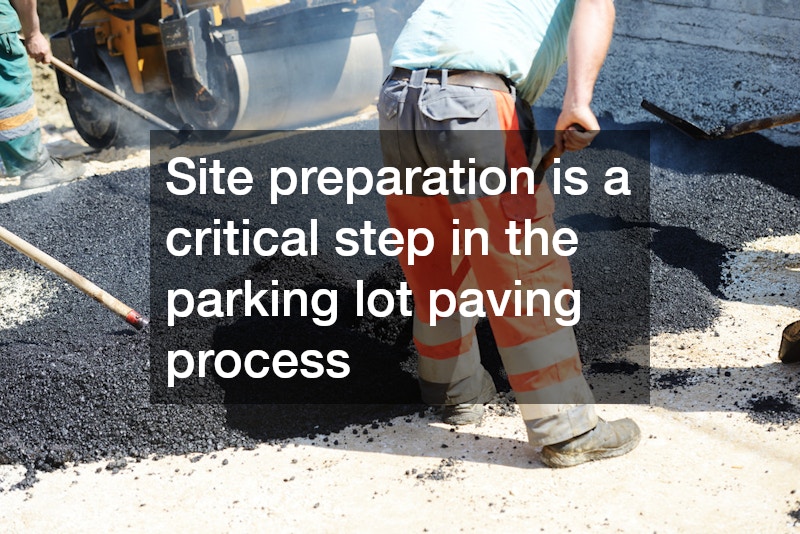Explore the fundamental process that a parking lot paving company follows to understand the essential steps involved in paving and what clients can expect throughout the project.
Initial Steps
The process of parking lot paving begins with thorough planning and consultation. Typically, a client will reach out to a paving company to discuss their needs, including the size and intended use of the parking lot.
The paving company will often schedule a site visit to assess the conditions and gather the necessary details to propose an appropriate plan.
After the initial consultation, the paving company will prepare a detailed estimate outlining the scope of work, the costs involved, and a timeline for completion. This estimate is essential for clients to understand the financial commitment and to compare different paving contractors if desired. It may also include recommendations regarding materials and design options that might suit the parking lot’s intended use.
Once the estimate is accepted, a formal contract is signed to solidify the project details. This contract serves as a legal agreement and ensures that both parties are clear about the expectations, responsibilities, and timelines. Setting these foundations is vital for a smooth paving process and helps prevent misunderstandings during the project.
Site Preparation
Site preparation is a critical step in the parking lot paving process, as it lays the groundwork for a durable surface. Initially, any existing pavement or debris will be removed, and the area will be cleared to create a blank slate. This step is essential for addressing any underlying issues, such as soil compaction or poor drainage, that may affect the longevity of the parking lot.
Next, grading and leveling are performed to ensure proper drainage and to create a smooth base for the pavement. The grading process involves adjusting the slope of the soil to direct water away from any structures and into designated drainage areas. This step is crucial in preventing future issues with water pooling, which can lead to structural damage or premature wear of the pavement.
Finally, the installation of a sub-base layer is executed. The sub-base typically consists of crushed stone or gravel, which provides a stable foundation for the asphalt or concrete to be laid on top. Compaction of this layer is necessary to achieve the right density and prevent settling, ensuring that the paving lasts for years to come. This thorough preparation is essential for a successful paving project.
Material Selection
Various materials are available for parking lot paving, each with its own advantages and applications. Asphalt is one of the most commonly used materials due to its cost-effectiveness, quick installation, and flexible nature. It is suitable for various climates and provides a durable surface for vehicle traffic.
Concrete is another popular option, known for its longevity and strength. While it typically has a higher initial cost compared to asphalt, concrete often requires less maintenance over its lifespan. Many choose concrete for larger parking lots, as it can accommodate heavy loads and heavy traffic without significant deterioration.
In addition to asphalt and concrete, some paving companies may offer alternatives such as permeable paving. This eco-friendly option allows water to percolate through the surface, reducing runoff and promoting drainage. Choosing the right material depends on various factors, such as climate, budget, and the intended use of the parking lot, making it essential for clients to discuss these options with their paving contractor.
Paving Methods
The paving method chosen can greatly impact the final result. One common method is traditional hot-mix asphalt paving, where asphalt is mixed and laid while hot, ensuring a strong bond with the sub-base. This method is effective for most parking lots, providing a smooth and durable surface for vehicles.
Additionally, companies may employ a technique called cold-patch paving, which utilizes a mix that is ready to use without heating. This method is often deployed for repairs or smaller resurfacing jobs, offering a more convenient option for quick fixes or maintenance on existing lots.
Another method is overlay paving, which involves laying a new layer of asphalt over an existing surface. This is an effective solution for improving the appearance and performance of an aging parking lot while minimizing the need for complete reconstruction. By selecting the appropriate paving method, a parking lot paving company can optimize both cost and durability for its clients.
Quality and Longevity
Ensuring quality and longevity in parking lot paving involves careful adherence to industry standards and best practices. Most reputable companies will employ skilled workers who understand the intricacies of paving, from proper equipment usage to effective material handling. Training and experience play a crucial role in achieving a polished final product that meets client expectations.
Regular inspections and testing throughout the paving process are also essential. Companies often conduct surface tests to ensure that the asphalt or concrete meets specified thickness and density requirements. These quality control measures help identify any potential issues early on, allowing them to be addressed before completion.
Finally, ongoing maintenance provides a key component in the longevity of paved surfaces. Parking lot paving companies may offer maintenance services, such as seal coating or surface repairs, to enhance the lifespan of the pavement. By encouraging clients to invest in regular upkeep, paving companies can help maintain the quality and safety of parking lots over time.
Understanding the basic process a parking lot paving company follows can help clients make informed decisions and ensure a successful paving project. From the initial consultation through to site preparation, material selection, and the paving methods used, each step plays a vital role in creating a durable and functional parking area. By choosing a knowledgeable paving contractor and staying informed about the process, clients can enjoy a high-quality parking lot that stands the test of time.





